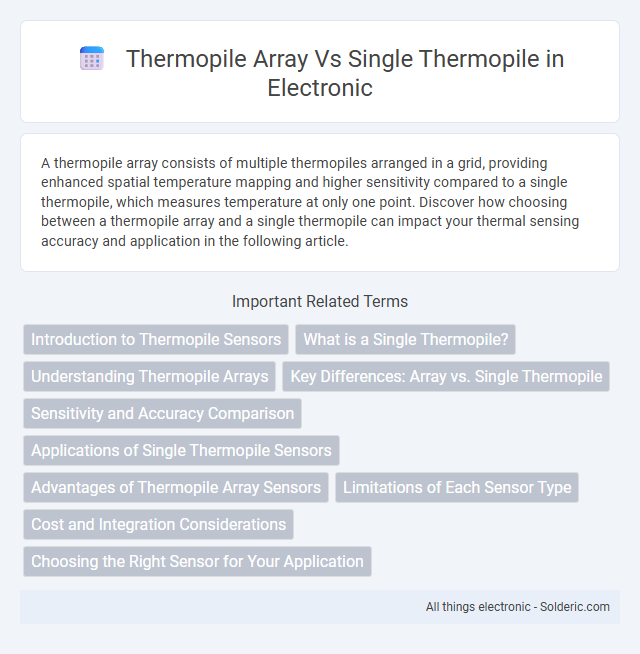A thermopile array consists of multiple thermopiles arranged in a grid, providing enhanced spatial temperature mapping and higher sensitivity compared to a single thermopile, which measures temperature at only one point. Discover how choosing between a thermopile array and a single thermopile can impact your thermal sensing accuracy and application in the following article.
Comparison Table
| Feature | Thermopile Array | Single Thermopile |
|---|---|---|
| Structure | Multiple thermopile sensors arranged in a grid | Single thermopile sensor element |
| Measurement | Spatial temperature mapping | Point temperature measurement |
| Resolution | High spatial resolution | Single data point |
| Applications | Thermal imaging, motion detection, temperature profiling | Non-contact temperature sensing, spot temperature monitoring |
| Cost | Higher due to complex array design | Lower, simpler design |
| Size | Larger footprint to accommodate array | Compact and small |
| Data Output | Multi-channel output providing temperature distribution | Single output representing average temperature |
| Complexity | Requires advanced signal processing | Simpler circuitry and calibration |
Introduction to Thermopile Sensors
Thermopile sensors convert thermal energy into electrical signals by measuring temperature differences across multiple thermocouples connected in series. A thermopile array consists of multiple thermopile elements arranged to provide spatial temperature mapping, enhancing detection accuracy and resolution in applications like infrared imaging and temperature profiling. Single thermopile sensors offer simpler designs suitable for point temperature measurements but lack the spatial sensitivity and detail provided by array configurations.
What is a Single Thermopile?
A single thermopile consists of multiple thermocouples connected in series or parallel to measure temperature differences by converting thermal energy into electrical voltage. It provides a focused and precise temperature measurement at one specific point, making it ideal for applications requiring high accuracy. Your choice between a single thermopile and a thermopile array depends on whether you need detailed temperature mapping or targeted spot measurement.
Understanding Thermopile Arrays
Thermopile arrays consist of multiple thermocouples arranged to capture spatial temperature variations, providing detailed thermal imaging compared to a single thermopile that measures temperature at one point. These arrays enhance sensitivity and resolution, enabling applications like infrared imaging and non-contact temperature measurement with greater accuracy. Integration of thermopile arrays in sensors supports real-time monitoring and precise thermal mapping in industrial and medical diagnostics.
Key Differences: Array vs. Single Thermopile
Thermopile arrays consist of multiple thermocouples connected in series or parallel, enabling spatial temperature mapping and higher sensitivity compared to a single thermopile sensor. Single thermopiles measure temperature at a single point, offering simpler design and faster response but limited spatial resolution. Arrays provide enhanced thermal imaging capabilities crucial for applications like infrared sensing and gas detection, where detailed temperature distribution is required.
Sensitivity and Accuracy Comparison
Thermopile arrays offer enhanced sensitivity compared to single thermopiles by capturing temperature gradients across multiple points, enabling more detailed thermal mapping and improved spatial resolution. Single thermopiles provide accurate temperature measurements at a specific point but may miss nuanced variations, limiting overall accuracy in complex environments. Your choice between the two depends on whether you require high-resolution temperature distribution (thermopile array) or focused, precise readings at one spot (single thermopile).
Applications of Single Thermopile Sensors
Single thermopile sensors excel in precision temperature measurement for applications like non-contact thermometers, HVAC systems, and industrial process monitoring. Their sensitivity to infrared radiation enables accurate detection of surface temperatures, making them ideal for medical diagnostics and environmental monitoring. You can rely on single thermopile sensors for compact, energy-efficient solutions in thermal sensing tasks requiring focused temperature readings.
Advantages of Thermopile Array Sensors
Thermopile array sensors provide enhanced spatial resolution by detecting temperature variations across multiple pixels, enabling precise thermal imaging compared to a single thermopile sensor's point measurement. These arrays offer improved sensitivity and faster response times due to parallel processing of thermal data, which is critical in applications like gas detection, medical diagnostics, and non-contact temperature monitoring. The ability to capture detailed thermal patterns facilitates advanced heat mapping and target tracking, expanding the functional capabilities beyond the limitations of single thermopile sensors.
Limitations of Each Sensor Type
Thermopile arrays face limitations such as lower spatial resolution and higher power consumption compared to single thermopiles, which can hinder precise temperature mapping. Single thermopiles have a limited field of view and provide point-based temperature readings, making them less effective for imaging applications. Understanding your application's requirements is crucial to choosing between the broader coverage of thermopile arrays and the simplicity of single thermopiles.
Cost and Integration Considerations
Thermopile arrays offer enhanced spatial resolution and multi-point temperature sensing but come with higher manufacturing costs and increased integration complexity compared to single thermopiles. Single thermopiles provide a cost-effective solution with simpler integration due to fewer components and reduced signal processing requirements. Choosing between them depends on application needs, balancing budget constraints and the necessity for detailed thermal mapping.
Choosing the Right Sensor for Your Application
Thermopile arrays offer enhanced spatial resolution and multi-point temperature measurement, making them ideal for applications requiring precise thermal mapping or imaging. Single thermopiles provide accurate point temperature sensing with simpler integration and lower cost, suitable for basic temperature monitoring tasks. Selecting the right sensor depends on the complexity of thermal data needed, budget constraints, and the specific measurement environment.
thermopile array vs single thermopile Infographic

 solderic.com
solderic.com